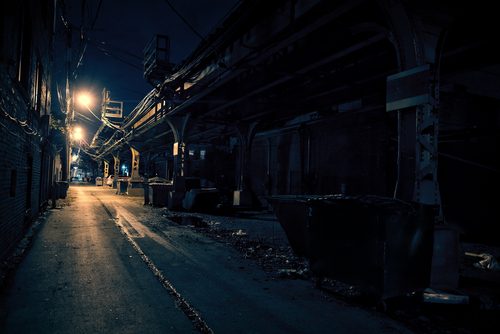
Berner Street (now Henriques Street)
The crime scene of Elizabeth Stride was the first location to be altered, as early as 1909, when Dutfield’s Yard, the International Workingmen’s Club and all the neighbouring cottages were demolished to make way for the Harry Gosling Primary School and its playground. In fact, very little of the original Berner Street remains, and it was renamed Henriques Street in the 1960’s to commemorate Basil Henriques, a Jewish philanthropist who set up the Bernhard Baron St George Jewish Settlement in the street in the early 20th century.
Mitre Square
Of all the Jack the Ripper murder sites, Mitre Square has been redeveloped most frequently. Once a small enclosure surrounded by imposing grim warehouses, these buildings were demolished in stages throughout the 1970’s to be replaced by modern office blocks, construction of which can be seen briefly in a sequence in the documentary ‘Jack the Ripper: The Final Solution’, filmed in 1980. The square still had a little character owing to the survival of old cobblestones, however, whether these were the original ones has always been debated. ‘Ripper’s Corner’, where the body of Catherine Eddowes was found, was for many years, accompanied by a small flowerbed and seats. In 2015, the 1970’s blocks were demolished after remaining unused for many years and the new, ultra-modern One Mitre Square was completed in 2018, changing the appearance of the square dramatically. Mitre Square now has a much more open appearance, with landscaping features such as grass, trees and seating areas for the City workers to enjoy lunch.
Wentworth Dwellings, Goulston Street
After the piece of Catherine Eddowes’ apron and the writing on the wall above it were found, Wentworth Dwellings gradually fell into disrepair and were lucky not to have been flattened by wartime bombing. They were closed and derelict by the 1980’s but were miraculously refurbished in the 1990’s as apartments again and were renamed Merchant House. The entrance to 108-119 Wentworth Dwellings, once bricked up, were converted into an entrance to Happy Days fish and chip restaurant and despite the changes, still features its distinctive original architectural decor over the top, as do all the surviving doorways. Happy Days Restaurant is a popular haunt for hungry Ripperologists, and inside are many photos of the doorway over the years, East End street scenes, Ripper suspects, and a small replica of the infamous graffiti that was found there in 1888.
Dorset Street
Dorset Street, once described as ‘the worst street in London’, was renamed Duval Street in 1904, mainly to eradicate its terrible reputation, as a number of other murders took place there after Mary Kelly’s in November 1888. Miller’s Court was closed off during the first World War as a health hazard and it, and the entire north side of the street, was demolished in 1928 to make way for the Spitalfields Market Fruit and Wool Exchange, opened the following year. The south side, still with some of its original doss-houses, came down in the 1960s and the whole street became a wide lorry park for vehicles servicing the market. When the White’s Row carpark was built in the early 70’s, Duval Street (though officially unnamed and a private road) was back on the map, staying this way until 2015 when the rear of the exchange and the car park were demolished to make way for an ambitious new development which filled the entire block, thus eradicating that as the most notorious of streets. On Crispin Street, opposite where Dorset Street once emerged, is Lillian Knowles House, now accommodation for students, but previously the Providence Row Night Shelter, where some would have it that Mary Kelly lived for a brief period of time. However, this appealing rumour has never been confirmed.
Check it out for yourself – book yourself on the number one Jack the Ripper tour in London. Book online or give our team a call on 07803 067544 today.